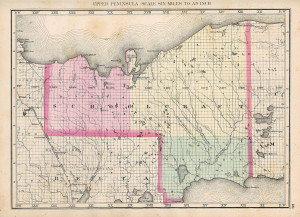Schoolcraft county was organized in 1876. It is bounded on the north by Lake Superior, on the east by Chippewa and Mackinac, on the south by Delta and Lake Michigan, on the west by Delta and Marquette. It is the fourth county in the State in size, and has an area of 2,196 square miles. Manistique, a growing town of 700 inhabitants, situated in the southern portion of the county on Lake Michigan, is the county seat. The northern and northwestern portions of the county are heavily timbered with white pine of good quality, growing on land also heavily timbered with maple, birch, and bass wood. The soil in this section is a sandy loam. The middle and western part comprises what is known as the Manistique flats—lands generally level, but with a descent to the southeast sufficient for drainage. Those lands have been largely overflowed, occasioned by beaver dams in the numerous streams or branches of the Manistique. The soil is a vegetable deposit or muck with a subsoil of marl, clay, and sand, underlaid with lime rock. Large marshes are interspersed with grass of the finest quality. The timber is principally pine on the ridges, and spruce, cedar, etc., near the rivers. The eastern and southern portions are more rolling and timbered with hardwood maple, birch, basswood, and elm on the highlands, and cedar, pine, and hemlock on the lower lands. The soil is a dark sand loam on lime rock and clay, and is a very desirable agricultural region. Homestead entries are numerous and the settlers prosperous. This portion embraces a portion of the Manistique lake region.
The county is well watered by the Manistique and its numerous tributaries, the head waters of the Sturgeon and Whiteflsh rivers, and numerous smaller streams which flow into Lake Michigan or Green Bay, also by the Chocolate and Au Sable rivers which flow into Lake Superior. Any number of fine water powers are to be found on the Manistique and its branches. Wheat, oats, grass, and all sorts of garden vegetables grow abundantly in this county. The seasons are generally too short for corn, although occasionally good crops have matured. Crops generally mature in this latitude much more rapidly than farther south. Wheat yields from 30 to 40 bushels to the acre. Potatoes from 250 to 350 bushels. In fact the latter crop never fails, and the quality cannot be excelled. Cabbages and other vegetables attain an enormous growth. Fruits, as a rule, have not been successful, but currants, cherries, strawberries, cranberries, and huckleberries grow to great perfection.
The cost of clearing, including fencing, averages from $20 to $30 per acre. Good wood markets are found along the line of the Detroit, Mackinac and Marquette railroad, and at the villages and mills along the lakes. Hard wood sells in Manistique at from $2.50 to $4 per cord. At the kilns in the north part of the county wood brings $2 per cord. There were 80,400 acres of government, 40 acres of State swamp, 33,241 acres of primary school, 21,482 acres of Lake Superior ship canal, 378,300 acres of Detroit, Mackinac and Marquette railroad, and 73,600 acres of Chicago and Northwestern railroad land, for sale May 1st, 1883. There are large tracts of good, unimproved agricultural lands within a few miles of settlements, having a strong clay soil with limestone foundation, which can be had at prices ranging from $1.25 to $6 per acre. The “stump lands” of this county have not, as yet, come into the market as farming lands, owing to the cheapness and abundance of timbered lands.
A state road extends from Manistique to Day’s river in Delta county, 65 miles in length. Many roads have been cut through the county, none of which are complete, yet they are never very muddy, and are extensively traveled. Snow falls by December 15th. and remains until April 1st. The average depth is from two to four feet. Farmers plow in April and May, and plant early in June.
The schools of the county are few, but every effort is made to have them efficient. Lumbering, the cutting of ties, posts, and poles, and charcoal burning are the principal industries, employing a large number of men, at wages ranging from $26 to $30 per month with board in the lumber camps, and $1.50 to $2.00 at the mills. Skilled labor is proportionately higher. The Detroit, Mackinac and Marquette railroad passes through the county from east to west, and furnishes a good outlet for all of its products. There are good harbors on the shore of Lake Michigan, and favorable opportunities for getting out cedar and other varieties of timber. Settlers who now burn fine hard woods in clearing land would gladly furnish them to parties who would undertake the labor of removing them.
Schoolcraft county offers special inducements to the settler with limited means. The county has developed rapidly during the past two years, yet there is every prospect that the next few years will witness a vast change, owing to the fact that the attention of farmers, mechanics, and manufacturers has been attracted by the reports of the wonderful advantages offered to every branch of business by this great county.

